-

Win a Free Custom Engraved Brass Coin!!!
As a way to introduce our brass coins to the community, we will raffle off a free coin during the month of August. Follow link ABOVE for instructions for entering.
-
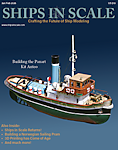
PRE-ORDER SHIPS IN SCALE TODAY!
The beloved Ships in Scale Magazine is back and charting a new course for 2026!
Discover new skills, new techniques, and new inspirations in every issue.
NOTE THAT OUR FIRST ISSUE WILL BE JAN/FEB 2026
You are using an out of date browser. It may not display this or other websites correctly.
You should upgrade or use an alternative browser.
You should upgrade or use an alternative browser.
It has been some time since posting. I finished the framing and planking and was not happy with the results of the planking. After the planking was done I removed the hull from the former/plug, (it came away cleanly) took a deep breath, and broke it apart and dumped the entire thing in the trash. I could have settled, but at this stage of my life, I want to do the best that I can, whatever that might be, and what I had on the first attempt on this model did not come close. Sooooo, I still have the plug and will restart. HOPEFULLY it will be a good result this time.
Allan
Allan
Respect.
Many thanks Paul!Respect.
Also my respect for this decision, Allan.It has been some time since posting. I finished the framing and planking and was not happy with the results of the planking. After the planking was done I removed the hull from the former/plug, (it came away cleanly) took a deep breath, and broke it apart and dumped the entire thing in the trash. I could have settled, but at this stage of my life, I want to do the best that I can, whatever that might be, and what I had on the first attempt on this model did not come close. Sooooo, I still have the plug and will restart. HOPEFULLY it will be a good result this time.
Allan
Regards, Peter
Thanks Peter. Hours spent in a pleasurable pastime are not diminished whether it is 50 or 100 or more. I TRY to see it as an opportunity to have more fun, not a loss of any kind other than a few pieces of wood. Maybe I should have let it rot in our rainy summer and then mount it and label it the HMS Bounty jollyboat, which was rotted through. (Not to be confused with the Bounty launch used by Captain Bligh and his crew when they were set adrift by the mutineers.)Also my respect for this decision
Back to making framing material.
Allan
Last edited:
Respect.
Also my respect for this decision, Allan.
Regards, Peter
Double ditto
- Joined
- Apr 12, 2025
- Messages
- 285
- Points
- 158

I get it, Allan, 100%! I design custom mechanical equipment and specialized machinery for a living. It's an R&D game where one starts with a simple concept and then begins to experience far more failures than intended successes... until 'finally' reaching the finish line. I oft times cuss like a sailor when things don't go smoothly nor work as designed/predicted, but I love it all just the same!Hours spent in a pleasurable pastime are not diminished
Started over with the new keel, stem, post, deadwood, transom and planking. It came out much better than the first try. I searched for information on painting these boats and I did find a few photos with the hulls payed or primed on the lower part of the hull. Some followed the shear of the planking, others followed the waterline. I also found a contract that called for the hull to be primed from the waterline down as well.
I thought it looked great until I took photos. Blowing up the photos shows every tiny imperfection so a great tool to use on any model as it progresses. There are a few spots that still need attention (scraping), but overall I am much happier than the first attempt.
Example of a painted barge model made in 1794
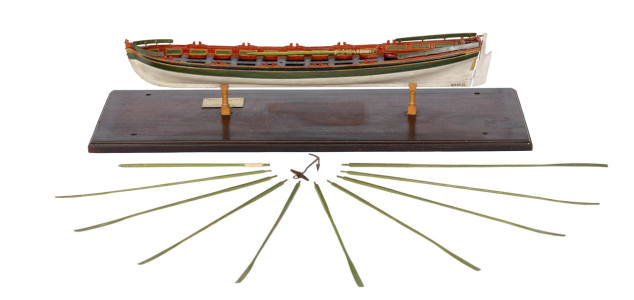
Example of a longboat model made in 1742
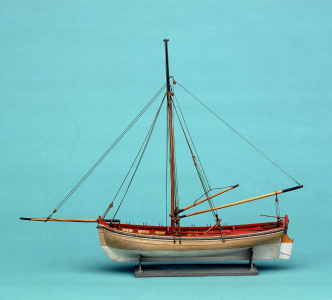
Boat on fully rigged ship model with ship's boat made in 1761
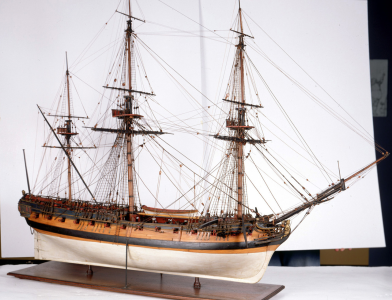
'My version of painting the hull
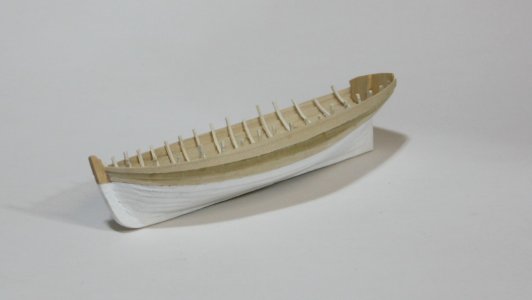

I do not look forward to building another lapstrake boat at a small scale in the future. After this experience I hope to stay with boats that are carvel built. I am not saying carvel planking is easy, just less difficult. Next up, keelson, footwaling, and risers.
Allan
I thought it looked great until I took photos. Blowing up the photos shows every tiny imperfection so a great tool to use on any model as it progresses. There are a few spots that still need attention (scraping), but overall I am much happier than the first attempt.
Example of a painted barge model made in 1794

Example of a longboat model made in 1742

Boat on fully rigged ship model with ship's boat made in 1761

'My version of painting the hull


I do not look forward to building another lapstrake boat at a small scale in the future. After this experience I hope to stay with boats that are carvel built. I am not saying carvel planking is easy, just less difficult. Next up, keelson, footwaling, and risers.
Allan
Last edited:
- Joined
- Oct 23, 2018
- Messages
- 875
- Points
- 403

It‘s looking great, Allan
- Joined
- Jun 29, 2024
- Messages
- 1,448
- Points
- 393

It certainly looks good to me!
In keeping with the original idea of using off the shelf materials and hand tools, power or manual, the thinnest materials can be a challenge. Birch ply in 1/64" and 1/32" works for almost all planks, be it the hull, footwaling, keelson, etc. I have the luxury of a thickness sander so normally make my own sticks of wood, but the birch aircraft ply is great.
The keelson and footwaling went in next. The risings followed. The thicknesses are shown in the scantlings list. The keelson is an inch thick and the footwaling 5/8". The breadth of the keelson is 9 but I could not find any information on the breadth of the strakes of footwaling. Looking as some cross section drawings and models I estimated the breadth. Not that there is a small gap between the strakes of footwaling. This was done so water could not accumulate on top of it where the oarsmen feet were sitting.
Allan
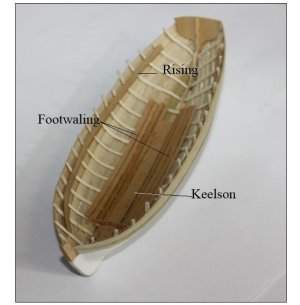
The keelson and footwaling went in next. The risings followed. The thicknesses are shown in the scantlings list. The keelson is an inch thick and the footwaling 5/8". The breadth of the keelson is 9 but I could not find any information on the breadth of the strakes of footwaling. Looking as some cross section drawings and models I estimated the breadth. Not that there is a small gap between the strakes of footwaling. This was done so water could not accumulate on top of it where the oarsmen feet were sitting.
Allan

Last edited:
I would love to find a source for plywood that thin over here. Your hull planking looks like poplar, but I assume the lighting and the contrast with the white paint are responsible for that.
Your hull planking looks like poplar
The hull is indeed poplar, the frames are holly and everything else is castello boxwood. I usually like to use holly for the hull planking, but thought to use a commonly available wood for this project. I was going to stay with it instead of castello for the other things, but wanted some color contrast.
Allan
- Joined
- Apr 12, 2025
- Messages
- 285
- Points
- 158

I've often wondered how well it would work to take long, thin shavings, from a Kanna, and glue them up with each layer slightly alternating in grain direction and heavily weighting things down until the really thinned out glue fully cures. Might be worth a try for thin DIY plywood.I would love to find a source for plywood that thin over here.
Raid one of those Kanna shaving contests and take all the shavings when they are through. Make some 60-ply 1/32" thick plywood!
Last edited:
This attempt is looking very nice, Allan. Your build has my interest because I have to make (later) for my Balder a 14-person lifeboat with lapstrake planking.In keeping with the original idea of using off the shelf materials and hand tools, power or manual, the thinnest materials can be a challenge. Birch ply in 1/64" and 1/32" works for almost all planks, be it the hull, footwaling, keelson, etc. I have the luxury of a thickness sander so normally make my own sticks of wood, but the birch aircraft ply is great.
The keelson and footwaling went in next. The risings followed. The thicknesses are shown in the scantlings list. The keelson is an inch thick and the footwaling 5/8". The breadth of the keelson is 9 but I could not find any information on the breadth of the strakes of footwaling. Looking as some cross section drawings and models I estimated the breadth. Not that there is a small gap between the strakes of footwaling. This was done so water could not accumulate on top of it where the oarsmen feet were sitting.
Allan
View attachment 533928
Regards, Peter
Making the ringbolts for the lift rings and eyes is pretty straight forward. While I have used and still occasionally use brass, my personal preference is copper wire as it easy to shape, strong, and much easier to blacken than brass.
At our small scales, making an eye bolt that does not stick up above the wood in which it is inserted is difficult. The size makes photos hard to see the details, but the drawing below should help. A is what the eyebolts usually looked like when secured on the ship. B is what we often see on models because it is very difficult to seat the eyebolt without carving out a groove, and C sits the loop low to the surface of the wood but without a full eye. Choices........
The eyes and rings for this scale are made of 24 gage copper wire.
Allan
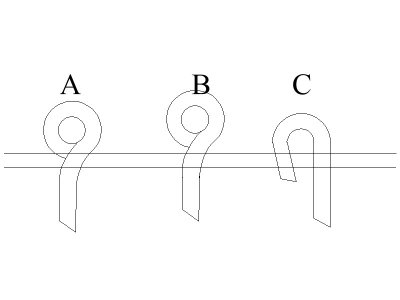
Making rings around a drill bit. Once the spring is made and removed from the bit, a snipper was used to cut multiple rings.
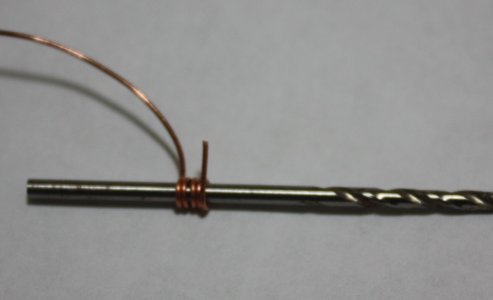
Pieces were soaked in acetone for a minute to remove any finger oils and such.
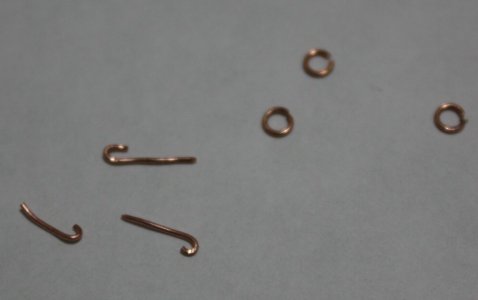
The cleaned pieces were brushed with diluted liver of sulfur and they blacken instantly. I left the tips unblackened so dot of glue will adhere to the copper, not the blackened portion. If the rings were to receive any stress I would have soldered the rings.
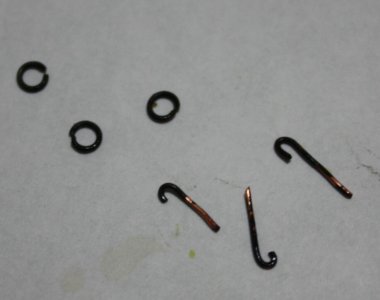
At our small scales, making an eye bolt that does not stick up above the wood in which it is inserted is difficult. The size makes photos hard to see the details, but the drawing below should help. A is what the eyebolts usually looked like when secured on the ship. B is what we often see on models because it is very difficult to seat the eyebolt without carving out a groove, and C sits the loop low to the surface of the wood but without a full eye. Choices........
The eyes and rings for this scale are made of 24 gage copper wire.
Allan

Making rings around a drill bit. Once the spring is made and removed from the bit, a snipper was used to cut multiple rings.

Pieces were soaked in acetone for a minute to remove any finger oils and such.

The cleaned pieces were brushed with diluted liver of sulfur and they blacken instantly. I left the tips unblackened so dot of glue will adhere to the copper, not the blackened portion. If the rings were to receive any stress I would have soldered the rings.

Last edited:


